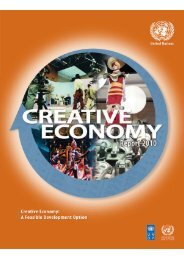Model curricula for journalism education for developing countries ...
Model curricula for journalism education for developing countries ...
Model curricula for journalism education for developing countries ...
Create successful ePaper yourself
Turn your PDF publications into a flip-book with our unique Google optimized e-Paper software.
ecause we believe a number of basic skills and capacities cannot be assumed<br />
when students begin their undergraduate studies in <strong>journalism</strong>. The axis that<br />
guides the portion of the curriculum dedicated to intellectual development there<strong>for</strong>e<br />
includes <strong>journalism</strong> as well as arts and science courses.<br />
The model <strong>curricula</strong> we propose below reflect the principles of the three axes. But<br />
there are two other principles that have also guided our work and that should be<br />
noted at the outset. One leads to a special emphasis on writing and reporting; the<br />
other leads to a careful allocation of time in the curriculum to ensure that courses<br />
dedicated to content and intellectual development are not marginalized.<br />
In each of the model <strong>curricula</strong> below, we propose that reporting and writing<br />
courses develop through a number of tiers in each semester of the program. As<br />
we will see, these courses constitute a <strong>curricula</strong>r core or spine, which promotes<br />
the refinement of writing and craft skills, makes it possible to offer <strong>journalism</strong><br />
<strong>education</strong> even without the latest equipment (though computers are essential), and<br />
points the way, where there is time in the curriculum, towards specialization in a<br />
single field such as politics, economics, arts and culture, social issues, international<br />
relations, and natural and physical science and associated subjects such as the<br />
environment, health, and technology. In other words, the goal is to <strong>for</strong>m journalists<br />
who are in command of the complex skills marking the craft and are also in<br />
command of the knowledge and thought to support the reporting and analysis<br />
called <strong>for</strong> in a beat. The vision guiding the <strong>for</strong>mation of journalists and expressed in<br />
the model <strong>curricula</strong> we propose there<strong>for</strong>e emphasizes intellectual development<br />
and the crafts of reporting and writing over sub-specialization in the various<br />
media.<br />
The second goal is strongly related to the first. We propose that the development<br />
of intellectual capacities, begun in the units of the <strong>journalism</strong> foundations course,<br />
be pursued not only in <strong>journalism</strong> courses but also in arts and science courses<br />
that would include, in the case of university students, a specialized academic field.<br />
The coursework in the arts and sciences would not simply provide a general<br />
background to professional courses, but would also include a disciplinary<br />
specialization. A university may combine the study of <strong>journalism</strong> with any discipline<br />
or interdisciplinary field of study providing it offers a minimum of three tiers of study<br />
(in a three-year degree) or four (in a four year degree) in that discipline or field. The<br />
<strong>journalism</strong> student would thus be able to take three or four full-year courses in such<br />
a discipline or field while progressing through three tiers of reporting instruction.<br />
Put differently, we propose that <strong>journalism</strong> students in university programs qualify<br />
not only in <strong>journalism</strong> but also in a separate academic field. We acknowledge that<br />
this may not be possible in all universities. Where fewer resources are available, the

















